Economics for Business: Australian Agribusiness and ASEAN Trade
VerifiedAdded on 2023/06/12
|9
|1527
|75
Report
AI Summary
This report examines the economic dynamics of Australian agribusiness within the ASEAN market, highlighting the growing demand for Australian agricultural products in Southeast Asian nations. It emphasizes that the ASEAN market presents a significant export opportunity, potentially exceeding that of China, driven by factors such as rising middle-class incomes, urbanization, and increasing meat consumption. The report delves into the demand and supply factors influencing this growth, noting the constraints on local food production within ASEAN countries. It recommends that Australian farmers focus on enhancing their competitiveness and aligning production with ASEAN's specific demands, shifting attention from an over-reliance on the Chinese market. The analysis uses economic theories related to demand, supply, and market equilibrium to explain the trade dynamics and concludes that the ASEAN region offers a promising avenue for increased agricultural exports and higher incomes for Australian farmers. Desklib provides access to similar reports and study tools for students.
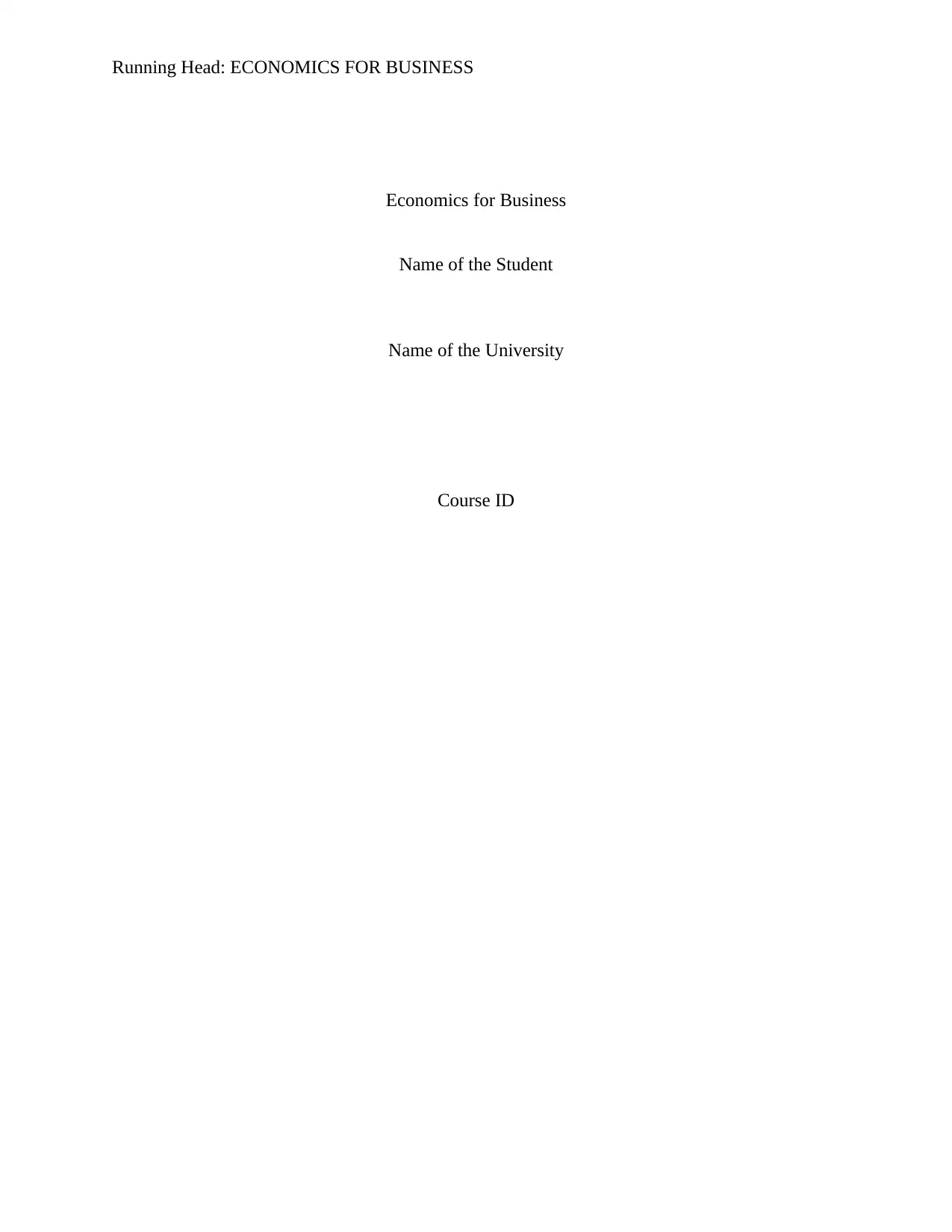
Running Head: ECONOMICS FOR BUSINESS
Economics for Business
Name of the Student
Name of the University
Course ID
Economics for Business
Name of the Student
Name of the University
Course ID
Paraphrase This Document
Need a fresh take? Get an instant paraphrase of this document with our AI Paraphraser
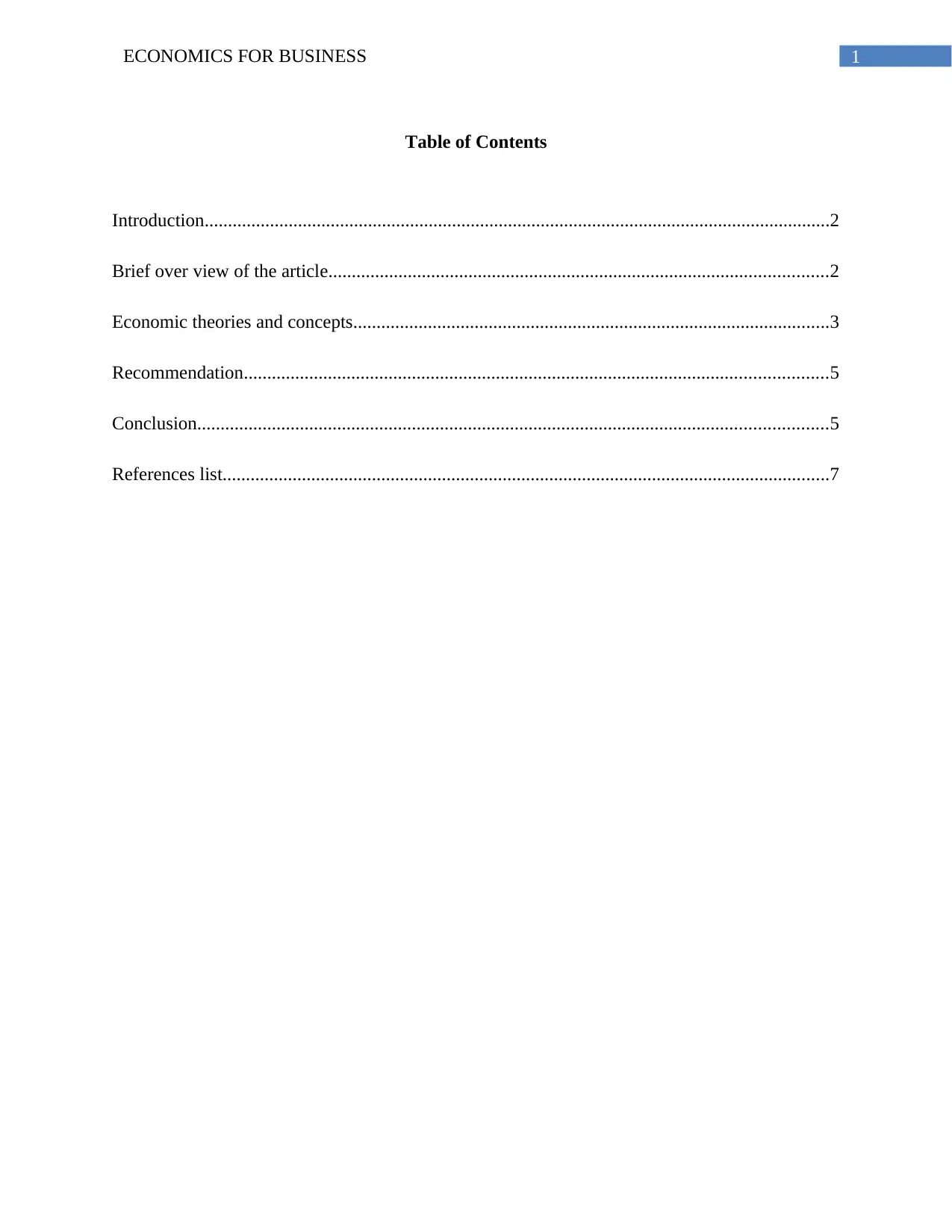
1ECONOMICS FOR BUSINESS
Table of Contents
Introduction......................................................................................................................................2
Brief over view of the article...........................................................................................................2
Economic theories and concepts......................................................................................................3
Recommendation.............................................................................................................................5
Conclusion.......................................................................................................................................5
References list..................................................................................................................................7
Table of Contents
Introduction......................................................................................................................................2
Brief over view of the article...........................................................................................................2
Economic theories and concepts......................................................................................................3
Recommendation.............................................................................................................................5
Conclusion.......................................................................................................................................5
References list..................................................................................................................................7
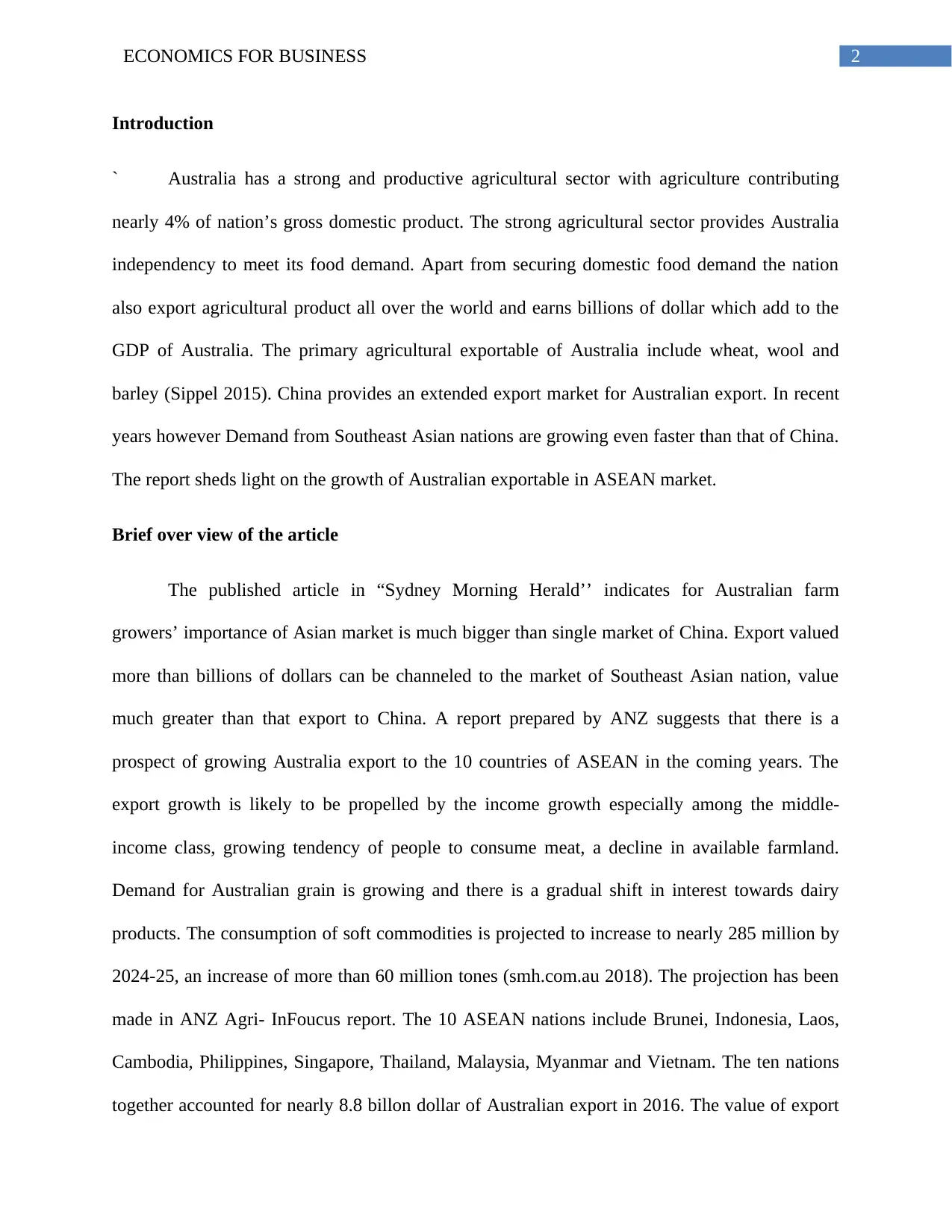
2ECONOMICS FOR BUSINESS
Introduction
` Australia has a strong and productive agricultural sector with agriculture contributing
nearly 4% of nation’s gross domestic product. The strong agricultural sector provides Australia
independency to meet its food demand. Apart from securing domestic food demand the nation
also export agricultural product all over the world and earns billions of dollar which add to the
GDP of Australia. The primary agricultural exportable of Australia include wheat, wool and
barley (Sippel 2015). China provides an extended export market for Australian export. In recent
years however Demand from Southeast Asian nations are growing even faster than that of China.
The report sheds light on the growth of Australian exportable in ASEAN market.
Brief over view of the article
The published article in “Sydney Morning Herald’’ indicates for Australian farm
growers’ importance of Asian market is much bigger than single market of China. Export valued
more than billions of dollars can be channeled to the market of Southeast Asian nation, value
much greater than that export to China. A report prepared by ANZ suggests that there is a
prospect of growing Australia export to the 10 countries of ASEAN in the coming years. The
export growth is likely to be propelled by the income growth especially among the middle-
income class, growing tendency of people to consume meat, a decline in available farmland.
Demand for Australian grain is growing and there is a gradual shift in interest towards dairy
products. The consumption of soft commodities is projected to increase to nearly 285 million by
2024-25, an increase of more than 60 million tones (smh.com.au 2018). The projection has been
made in ANZ Agri- InFoucus report. The 10 ASEAN nations include Brunei, Indonesia, Laos,
Cambodia, Philippines, Singapore, Thailand, Malaysia, Myanmar and Vietnam. The ten nations
together accounted for nearly 8.8 billon dollar of Australian export in 2016. The value of export
Introduction
` Australia has a strong and productive agricultural sector with agriculture contributing
nearly 4% of nation’s gross domestic product. The strong agricultural sector provides Australia
independency to meet its food demand. Apart from securing domestic food demand the nation
also export agricultural product all over the world and earns billions of dollar which add to the
GDP of Australia. The primary agricultural exportable of Australia include wheat, wool and
barley (Sippel 2015). China provides an extended export market for Australian export. In recent
years however Demand from Southeast Asian nations are growing even faster than that of China.
The report sheds light on the growth of Australian exportable in ASEAN market.
Brief over view of the article
The published article in “Sydney Morning Herald’’ indicates for Australian farm
growers’ importance of Asian market is much bigger than single market of China. Export valued
more than billions of dollars can be channeled to the market of Southeast Asian nation, value
much greater than that export to China. A report prepared by ANZ suggests that there is a
prospect of growing Australia export to the 10 countries of ASEAN in the coming years. The
export growth is likely to be propelled by the income growth especially among the middle-
income class, growing tendency of people to consume meat, a decline in available farmland.
Demand for Australian grain is growing and there is a gradual shift in interest towards dairy
products. The consumption of soft commodities is projected to increase to nearly 285 million by
2024-25, an increase of more than 60 million tones (smh.com.au 2018). The projection has been
made in ANZ Agri- InFoucus report. The 10 ASEAN nations include Brunei, Indonesia, Laos,
Cambodia, Philippines, Singapore, Thailand, Malaysia, Myanmar and Vietnam. The ten nations
together accounted for nearly 8.8 billon dollar of Australian export in 2016. The value of export
⊘ This is a preview!⊘
Do you want full access?
Subscribe today to unlock all pages.

Trusted by 1+ million students worldwide
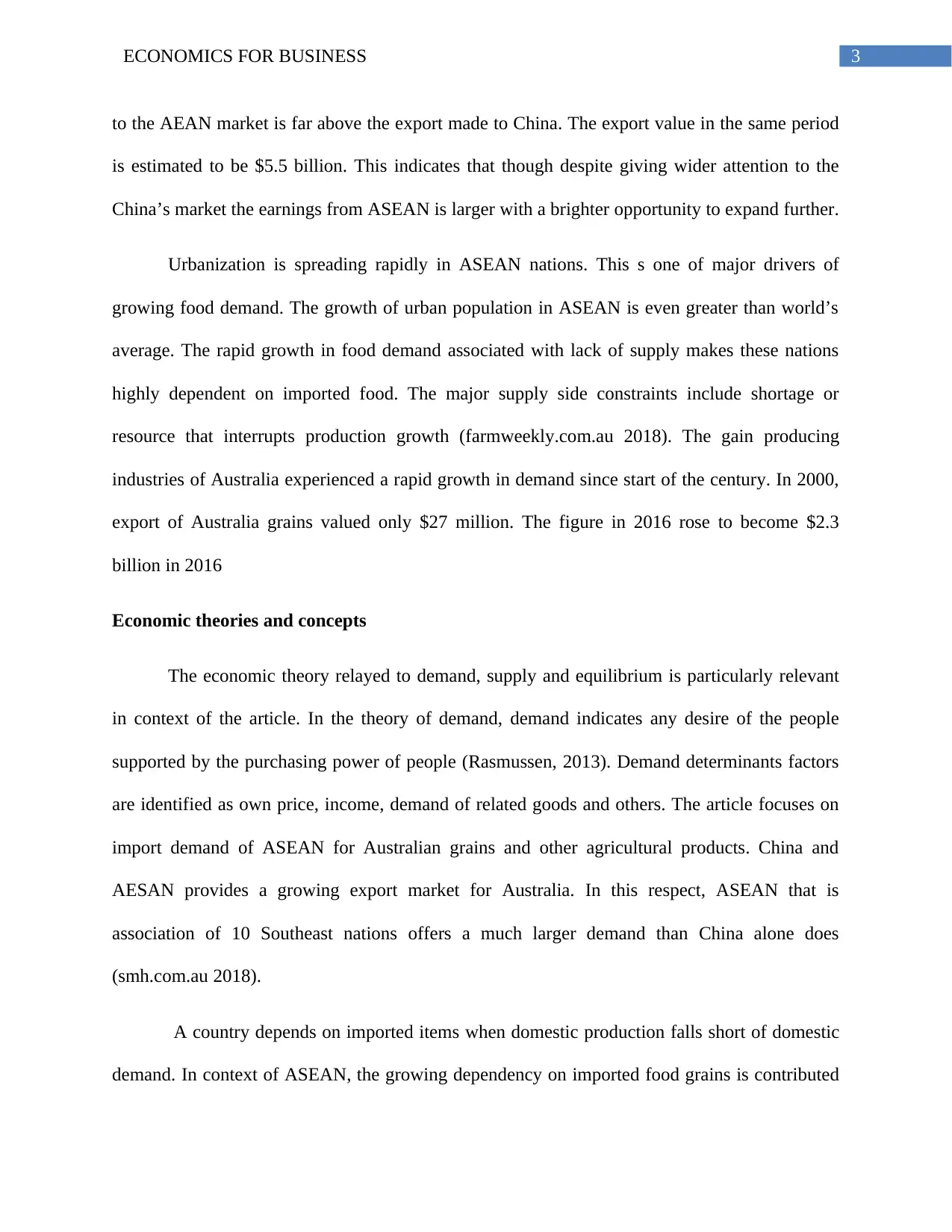
3ECONOMICS FOR BUSINESS
to the AEAN market is far above the export made to China. The export value in the same period
is estimated to be $5.5 billion. This indicates that though despite giving wider attention to the
China’s market the earnings from ASEAN is larger with a brighter opportunity to expand further.
Urbanization is spreading rapidly in ASEAN nations. This s one of major drivers of
growing food demand. The growth of urban population in ASEAN is even greater than world’s
average. The rapid growth in food demand associated with lack of supply makes these nations
highly dependent on imported food. The major supply side constraints include shortage or
resource that interrupts production growth (farmweekly.com.au 2018). The gain producing
industries of Australia experienced a rapid growth in demand since start of the century. In 2000,
export of Australia grains valued only $27 million. The figure in 2016 rose to become $2.3
billion in 2016
Economic theories and concepts
The economic theory relayed to demand, supply and equilibrium is particularly relevant
in context of the article. In the theory of demand, demand indicates any desire of the people
supported by the purchasing power of people (Rasmussen, 2013). Demand determinants factors
are identified as own price, income, demand of related goods and others. The article focuses on
import demand of ASEAN for Australian grains and other agricultural products. China and
AESAN provides a growing export market for Australia. In this respect, ASEAN that is
association of 10 Southeast nations offers a much larger demand than China alone does
(smh.com.au 2018).
A country depends on imported items when domestic production falls short of domestic
demand. In context of ASEAN, the growing dependency on imported food grains is contributed
to the AEAN market is far above the export made to China. The export value in the same period
is estimated to be $5.5 billion. This indicates that though despite giving wider attention to the
China’s market the earnings from ASEAN is larger with a brighter opportunity to expand further.
Urbanization is spreading rapidly in ASEAN nations. This s one of major drivers of
growing food demand. The growth of urban population in ASEAN is even greater than world’s
average. The rapid growth in food demand associated with lack of supply makes these nations
highly dependent on imported food. The major supply side constraints include shortage or
resource that interrupts production growth (farmweekly.com.au 2018). The gain producing
industries of Australia experienced a rapid growth in demand since start of the century. In 2000,
export of Australia grains valued only $27 million. The figure in 2016 rose to become $2.3
billion in 2016
Economic theories and concepts
The economic theory relayed to demand, supply and equilibrium is particularly relevant
in context of the article. In the theory of demand, demand indicates any desire of the people
supported by the purchasing power of people (Rasmussen, 2013). Demand determinants factors
are identified as own price, income, demand of related goods and others. The article focuses on
import demand of ASEAN for Australian grains and other agricultural products. China and
AESAN provides a growing export market for Australia. In this respect, ASEAN that is
association of 10 Southeast nations offers a much larger demand than China alone does
(smh.com.au 2018).
A country depends on imported items when domestic production falls short of domestic
demand. In context of ASEAN, the growing dependency on imported food grains is contributed
Paraphrase This Document
Need a fresh take? Get an instant paraphrase of this document with our AI Paraphraser
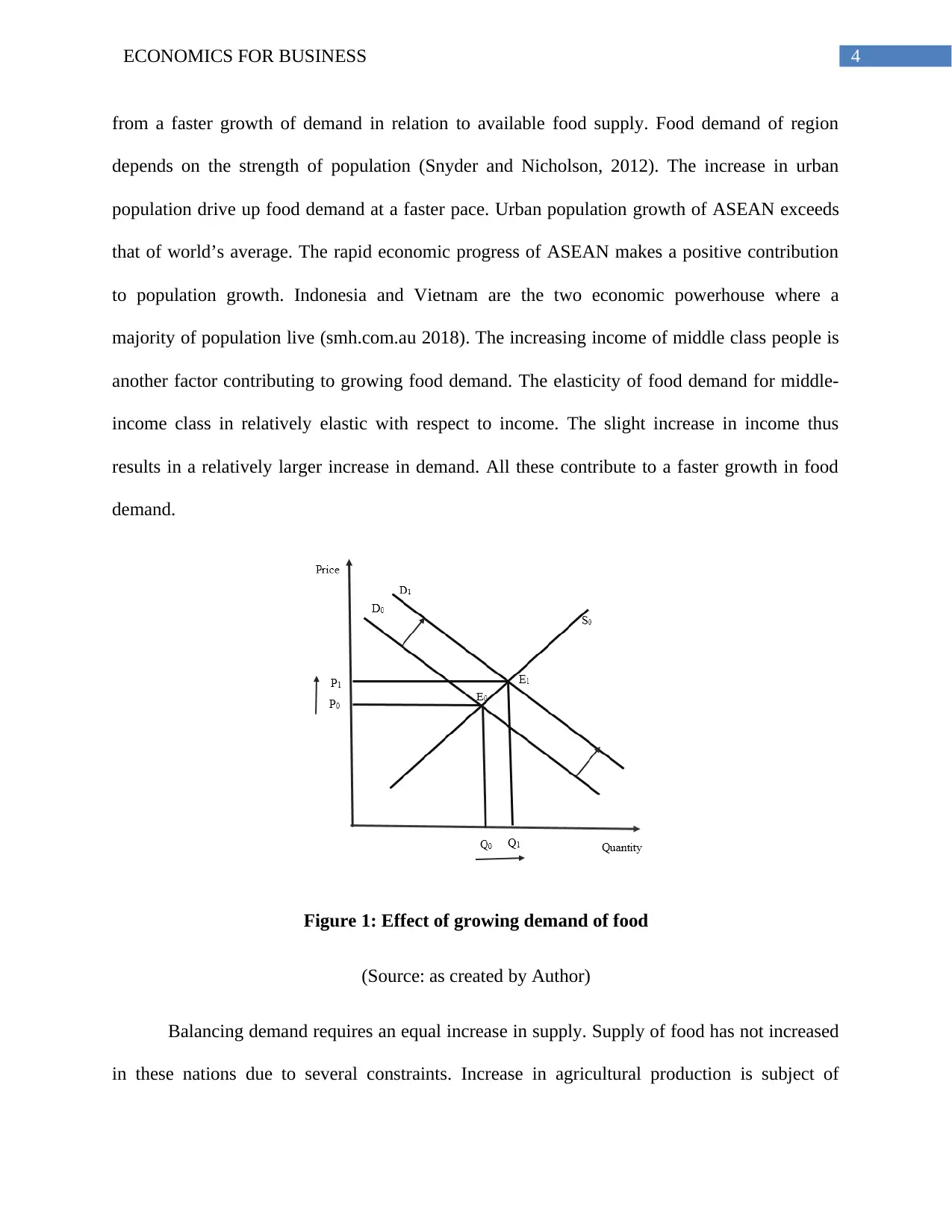
4ECONOMICS FOR BUSINESS
from a faster growth of demand in relation to available food supply. Food demand of region
depends on the strength of population (Snyder and Nicholson, 2012). The increase in urban
population drive up food demand at a faster pace. Urban population growth of ASEAN exceeds
that of world’s average. The rapid economic progress of ASEAN makes a positive contribution
to population growth. Indonesia and Vietnam are the two economic powerhouse where a
majority of population live (smh.com.au 2018). The increasing income of middle class people is
another factor contributing to growing food demand. The elasticity of food demand for middle-
income class in relatively elastic with respect to income. The slight increase in income thus
results in a relatively larger increase in demand. All these contribute to a faster growth in food
demand.
Figure 1: Effect of growing demand of food
(Source: as created by Author)
Balancing demand requires an equal increase in supply. Supply of food has not increased
in these nations due to several constraints. Increase in agricultural production is subject of
from a faster growth of demand in relation to available food supply. Food demand of region
depends on the strength of population (Snyder and Nicholson, 2012). The increase in urban
population drive up food demand at a faster pace. Urban population growth of ASEAN exceeds
that of world’s average. The rapid economic progress of ASEAN makes a positive contribution
to population growth. Indonesia and Vietnam are the two economic powerhouse where a
majority of population live (smh.com.au 2018). The increasing income of middle class people is
another factor contributing to growing food demand. The elasticity of food demand for middle-
income class in relatively elastic with respect to income. The slight increase in income thus
results in a relatively larger increase in demand. All these contribute to a faster growth in food
demand.
Figure 1: Effect of growing demand of food
(Source: as created by Author)
Balancing demand requires an equal increase in supply. Supply of food has not increased
in these nations due to several constraints. Increase in agricultural production is subject of
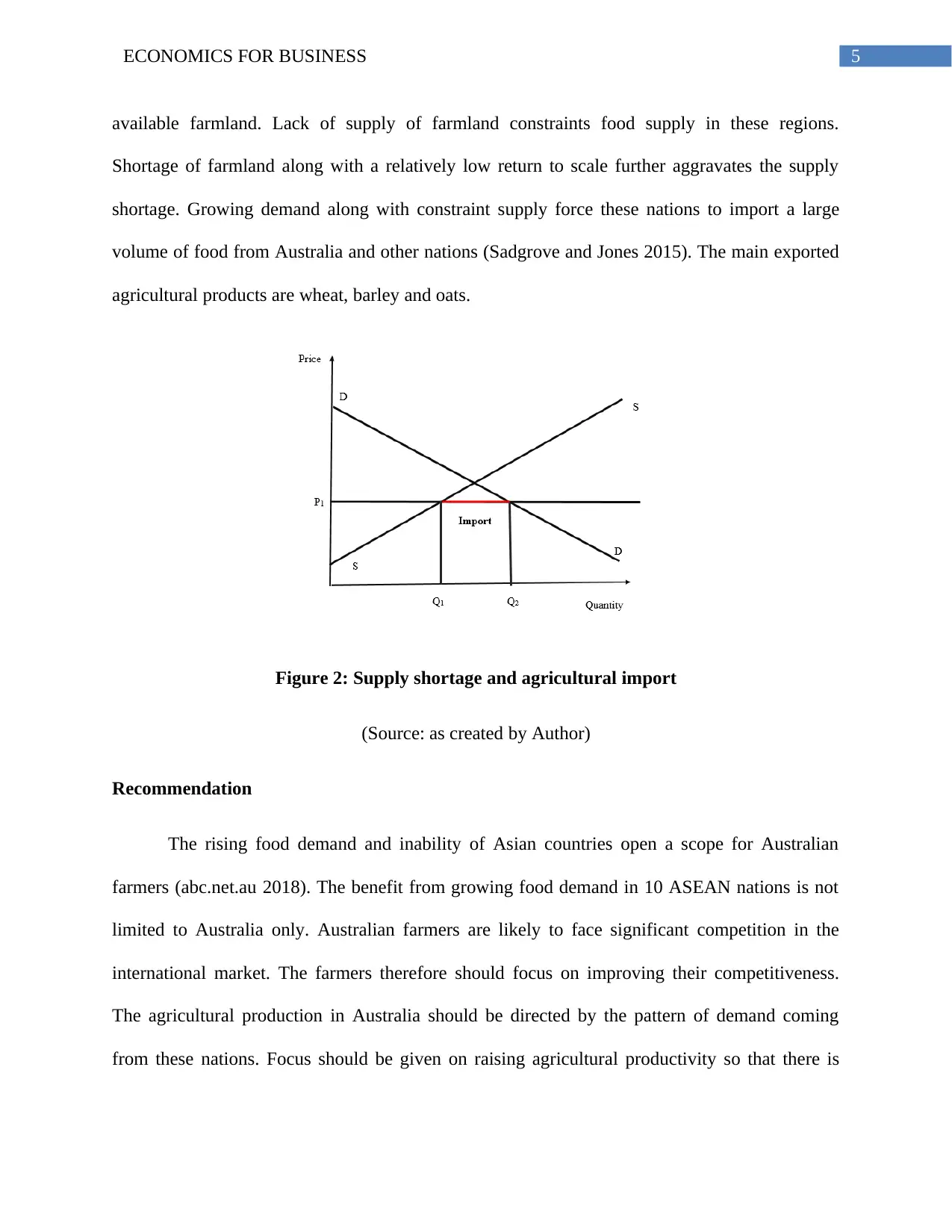
5ECONOMICS FOR BUSINESS
available farmland. Lack of supply of farmland constraints food supply in these regions.
Shortage of farmland along with a relatively low return to scale further aggravates the supply
shortage. Growing demand along with constraint supply force these nations to import a large
volume of food from Australia and other nations (Sadgrove and Jones 2015). The main exported
agricultural products are wheat, barley and oats.
Figure 2: Supply shortage and agricultural import
(Source: as created by Author)
Recommendation
The rising food demand and inability of Asian countries open a scope for Australian
farmers (abc.net.au 2018). The benefit from growing food demand in 10 ASEAN nations is not
limited to Australia only. Australian farmers are likely to face significant competition in the
international market. The farmers therefore should focus on improving their competitiveness.
The agricultural production in Australia should be directed by the pattern of demand coming
from these nations. Focus should be given on raising agricultural productivity so that there is
available farmland. Lack of supply of farmland constraints food supply in these regions.
Shortage of farmland along with a relatively low return to scale further aggravates the supply
shortage. Growing demand along with constraint supply force these nations to import a large
volume of food from Australia and other nations (Sadgrove and Jones 2015). The main exported
agricultural products are wheat, barley and oats.
Figure 2: Supply shortage and agricultural import
(Source: as created by Author)
Recommendation
The rising food demand and inability of Asian countries open a scope for Australian
farmers (abc.net.au 2018). The benefit from growing food demand in 10 ASEAN nations is not
limited to Australia only. Australian farmers are likely to face significant competition in the
international market. The farmers therefore should focus on improving their competitiveness.
The agricultural production in Australia should be directed by the pattern of demand coming
from these nations. Focus should be given on raising agricultural productivity so that there is
⊘ This is a preview!⊘
Do you want full access?
Subscribe today to unlock all pages.

Trusted by 1+ million students worldwide
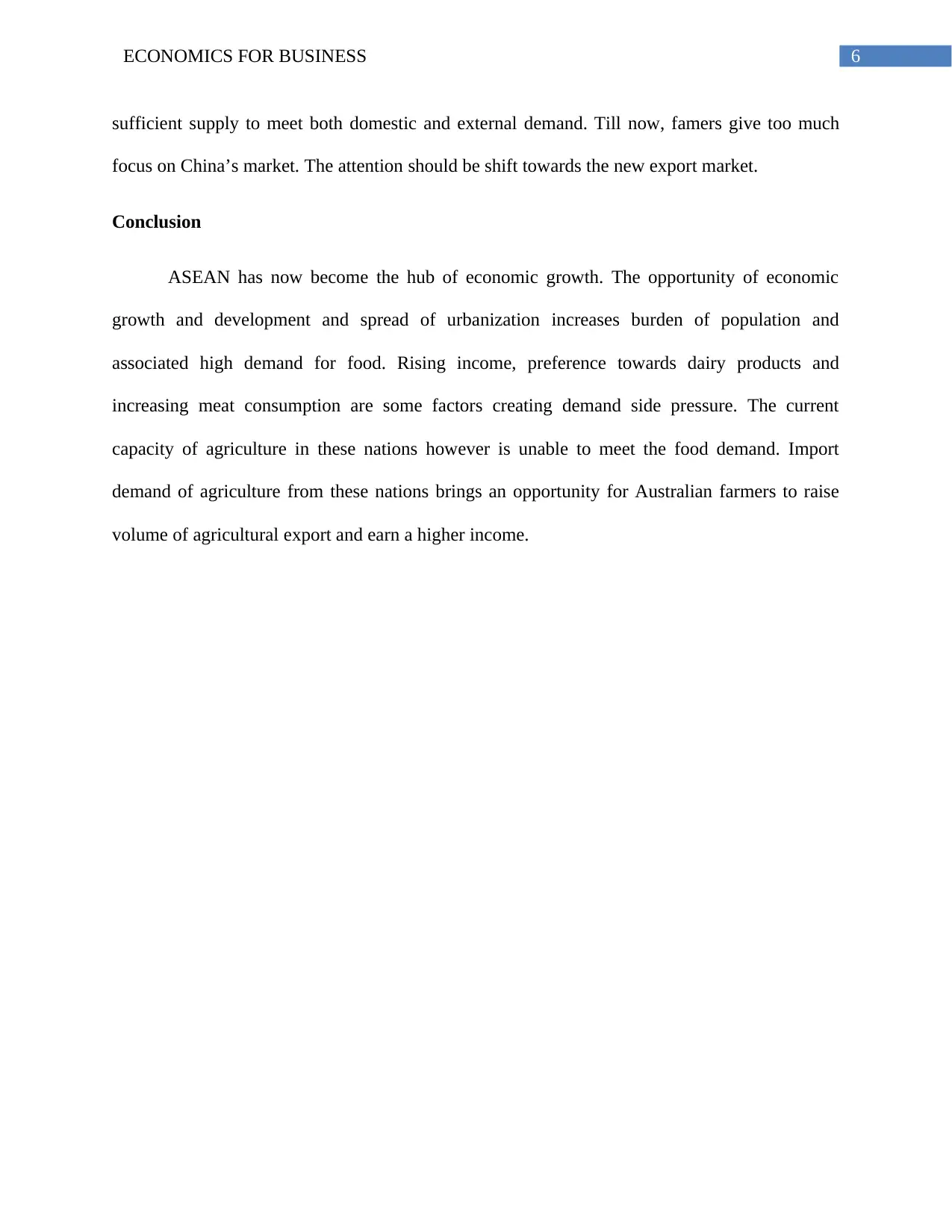
6ECONOMICS FOR BUSINESS
sufficient supply to meet both domestic and external demand. Till now, famers give too much
focus on China’s market. The attention should be shift towards the new export market.
Conclusion
ASEAN has now become the hub of economic growth. The opportunity of economic
growth and development and spread of urbanization increases burden of population and
associated high demand for food. Rising income, preference towards dairy products and
increasing meat consumption are some factors creating demand side pressure. The current
capacity of agriculture in these nations however is unable to meet the food demand. Import
demand of agriculture from these nations brings an opportunity for Australian farmers to raise
volume of agricultural export and earn a higher income.
sufficient supply to meet both domestic and external demand. Till now, famers give too much
focus on China’s market. The attention should be shift towards the new export market.
Conclusion
ASEAN has now become the hub of economic growth. The opportunity of economic
growth and development and spread of urbanization increases burden of population and
associated high demand for food. Rising income, preference towards dairy products and
increasing meat consumption are some factors creating demand side pressure. The current
capacity of agriculture in these nations however is unable to meet the food demand. Import
demand of agriculture from these nations brings an opportunity for Australian farmers to raise
volume of agricultural export and earn a higher income.
Paraphrase This Document
Need a fresh take? Get an instant paraphrase of this document with our AI Paraphraser
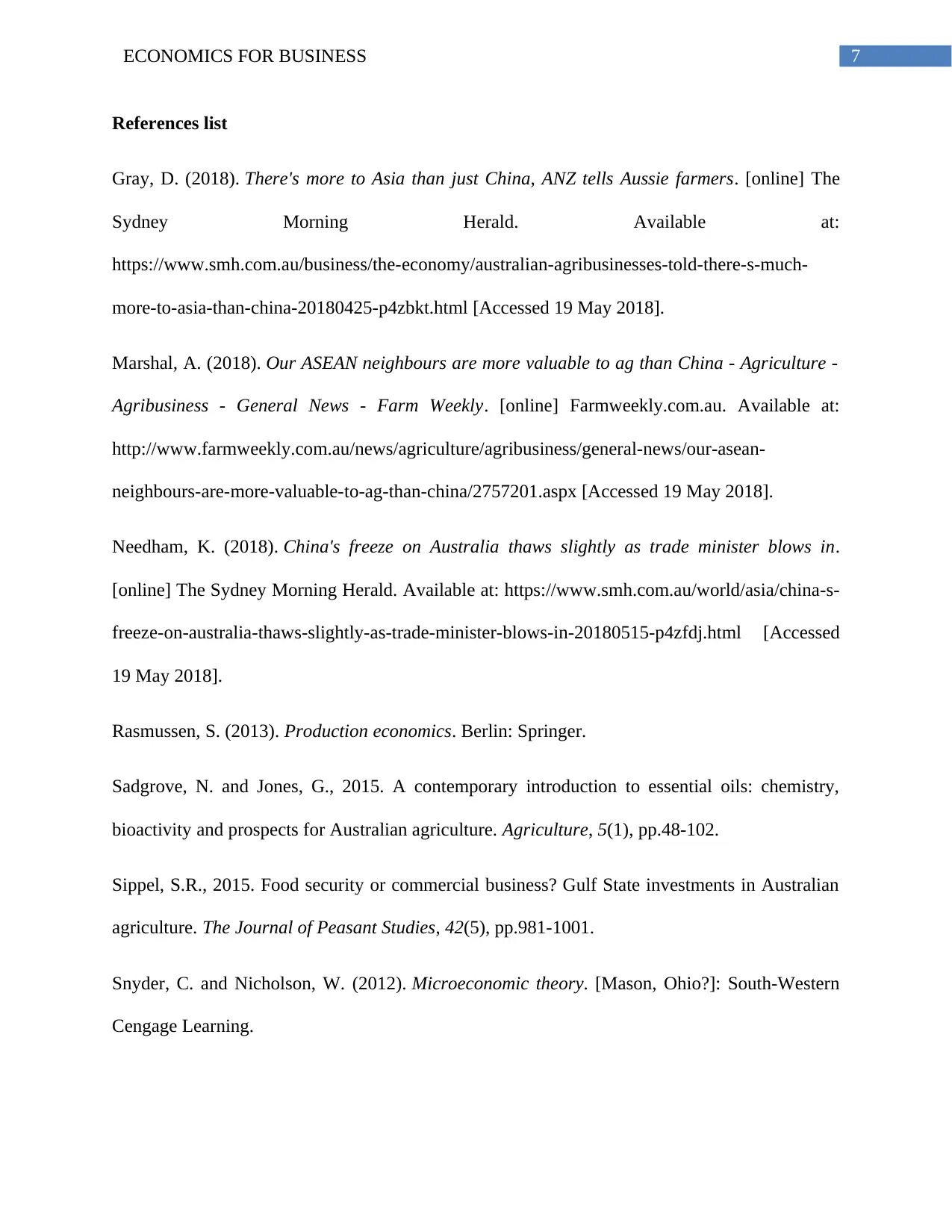
7ECONOMICS FOR BUSINESS
References list
Gray, D. (2018). There's more to Asia than just China, ANZ tells Aussie farmers. [online] The
Sydney Morning Herald. Available at:
https://www.smh.com.au/business/the-economy/australian-agribusinesses-told-there-s-much-
more-to-asia-than-china-20180425-p4zbkt.html [Accessed 19 May 2018].
Marshal, A. (2018). Our ASEAN neighbours are more valuable to ag than China - Agriculture -
Agribusiness - General News - Farm Weekly. [online] Farmweekly.com.au. Available at:
http://www.farmweekly.com.au/news/agriculture/agribusiness/general-news/our-asean-
neighbours-are-more-valuable-to-ag-than-china/2757201.aspx [Accessed 19 May 2018].
Needham, K. (2018). China's freeze on Australia thaws slightly as trade minister blows in.
[online] The Sydney Morning Herald. Available at: https://www.smh.com.au/world/asia/china-s-
freeze-on-australia-thaws-slightly-as-trade-minister-blows-in-20180515-p4zfdj.html [Accessed
19 May 2018].
Rasmussen, S. (2013). Production economics. Berlin: Springer.
Sadgrove, N. and Jones, G., 2015. A contemporary introduction to essential oils: chemistry,
bioactivity and prospects for Australian agriculture. Agriculture, 5(1), pp.48-102.
Sippel, S.R., 2015. Food security or commercial business? Gulf State investments in Australian
agriculture. The Journal of Peasant Studies, 42(5), pp.981-1001.
Snyder, C. and Nicholson, W. (2012). Microeconomic theory. [Mason, Ohio?]: South-Western
Cengage Learning.
References list
Gray, D. (2018). There's more to Asia than just China, ANZ tells Aussie farmers. [online] The
Sydney Morning Herald. Available at:
https://www.smh.com.au/business/the-economy/australian-agribusinesses-told-there-s-much-
more-to-asia-than-china-20180425-p4zbkt.html [Accessed 19 May 2018].
Marshal, A. (2018). Our ASEAN neighbours are more valuable to ag than China - Agriculture -
Agribusiness - General News - Farm Weekly. [online] Farmweekly.com.au. Available at:
http://www.farmweekly.com.au/news/agriculture/agribusiness/general-news/our-asean-
neighbours-are-more-valuable-to-ag-than-china/2757201.aspx [Accessed 19 May 2018].
Needham, K. (2018). China's freeze on Australia thaws slightly as trade minister blows in.
[online] The Sydney Morning Herald. Available at: https://www.smh.com.au/world/asia/china-s-
freeze-on-australia-thaws-slightly-as-trade-minister-blows-in-20180515-p4zfdj.html [Accessed
19 May 2018].
Rasmussen, S. (2013). Production economics. Berlin: Springer.
Sadgrove, N. and Jones, G., 2015. A contemporary introduction to essential oils: chemistry,
bioactivity and prospects for Australian agriculture. Agriculture, 5(1), pp.48-102.
Sippel, S.R., 2015. Food security or commercial business? Gulf State investments in Australian
agriculture. The Journal of Peasant Studies, 42(5), pp.981-1001.
Snyder, C. and Nicholson, W. (2012). Microeconomic theory. [Mason, Ohio?]: South-Western
Cengage Learning.

8ECONOMICS FOR BUSINESS
Vidot, A. (2018). Bright future for Australian food exports to Asia. [online] ABC Rural.
Available at: http://www.abc.net.au/news/rural/2013-10-10/abares-what-asia-wants/5013468
[Accessed 19 May 2018].
Vidot, A. (2018). Bright future for Australian food exports to Asia. [online] ABC Rural.
Available at: http://www.abc.net.au/news/rural/2013-10-10/abares-what-asia-wants/5013468
[Accessed 19 May 2018].
⊘ This is a preview!⊘
Do you want full access?
Subscribe today to unlock all pages.

Trusted by 1+ million students worldwide
1 out of 9
Related Documents
Your All-in-One AI-Powered Toolkit for Academic Success.
+13062052269
info@desklib.com
Available 24*7 on WhatsApp / Email
![[object Object]](/_next/static/media/star-bottom.7253800d.svg)
Unlock your academic potential
Copyright © 2020–2025 A2Z Services. All Rights Reserved. Developed and managed by ZUCOL.





